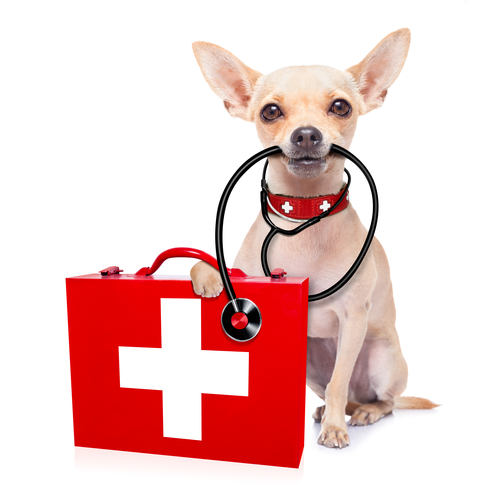
Humans aren’t the only ones who have health emergencies requiring first aid; our furry friends sometimes find themselves with cuts, bumps, scrapes, etc. needing attention. April being the National Pet First Aid Awareness Month, is an excellent time to learn animal life-saving skills and have a well-equipped up-to-date pet first aid kit easily accessible.
You most likely have many of the items at home already; it’s time to get them together in one place. Valuable time is often wasted running around for bandages and looking in cabinets for needed items. For minor health problems, or to stabilize your pet until it can be brought to a veterinarian, we have put together a pet first aid kit that can address pet injuries for dogs and cats.
The basic items for a pet first aid kit should include:
- Cold Pack – To treat burns, stings, heat stroke, and swollen joints.
- 3% Hydrogen Peroxide – To flush minor wounds and induce vomiting due to poisoning.
- Saline Solution or Eye Wash – To irrigate minor wounds and clean the eyes.
- Self-Adhering Bandage or Adhesive Tape– To secure rolled gauze in place.
- 4” X 4” Gauze Squares – To stop bleeding.
- Rolled Gauze – To fasten the gauze squares in place.
- Pure Aloe Vera Gel or Antibiotic Ointment – To soothe pain and promote healing.
- Needleless Syring or Eye Dropper – To dispense medications.
- Digital Thermometer – To examine your pet’s temperature.
- Cotton Swabs & Styptic Powder – To stop bleeding from a minor injury.
- Safety Scissors – To cut bandages or trim the fur around wounds.
- Tweezers – To extract tick or remove debris from a wound or in the mouth.
- Antihistamine Tablets – For allergic reactions or those times when snake bites or bee stings.
- Antacids – To calm an upset stomach.
- Cotton Buds & Cotton Pads – For cleanup and topical applications.
- Worming Treatments
- Electrolyte Replenisher – To aid in rehydration.
- Leash – To use as a muzzle temporarily.
- Blanket or Towel – To use as sling or stretcher or cover a pet who has gone into Shock.
- Sanitizer – For your hands after touching wounds.
- Pet First Aid Handbook – For necessary details you need to know.
- Phone Numbers & Addresses – To keep your vet’s emergency contact number readily available and the phone number to pet poison control.
- Storage Container with Snap Lock Lid – Put all of the items into the container, and do not forget to label the kit with your veterinarian’s emergency contact number. In case there’s an emergency on your hands, this saves you time by letting you call your vet for help while attending to your dog or cat.
Now that you’ve completed your pet first aid kit, where do you keep it? For the sake of safety, keep one in the house and another in the car.
If you use up an item in the pet first aid kit, you need to replace it! If it expires, get another, and…know how to properly use everything in your kit so that each time you need to pull a tick, bandage a wound or soothe an upset canine tummy, you are ready to go!
Don’t wish you had assembled a Pet First Aid Kit. Get the tools and learn what to do for those unavoidable times when your best friend has an injury.
Do you have a pet first aid kit for your dog or cat?
